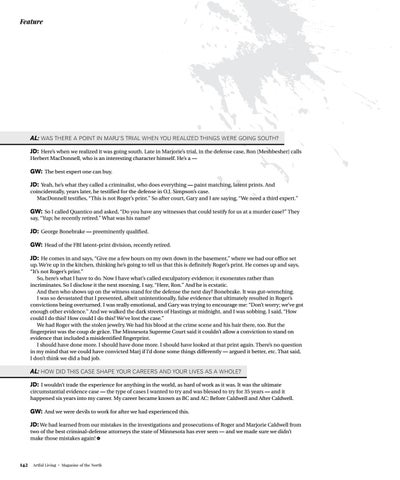Feature
AL: WAS THERE A POINT IN MARJ’S TRIAL WHEN YOU REALIZED THINGS WERE GOING SOUTH? JD: Here’s when we realized it was going south. Late in Marjorie’s trial, in the defense case, Ron [Meshbesher] calls Herbert MacDonnell, who is an interesting character himself. He’s a —
GW: The best expert one can buy. JD: Yeah, he’s what they called a criminalist, who does everything — paint matching, latent prints. And coincidentally, years later, he testified for the defense in O.J. Simpson’s case. MacDonnell testifies, “This is not Roger’s print.” So after court, Gary and I are saying, “We need a third expert.”
GW: So I called Quantico and asked, “Do you have any witnesses that could testify for us at a murder case?” They say, “Yup; he recently retired.” What was his name?
JD: George Bonebrake — preeminently qualified. GW: Head of the FBI latent-print division, recently retired. JD: He comes in and says, “Give me a few hours on my own down in the basement,” where we had our office set up. We’re up in the kitchen, thinking he’s going to tell us that this is definitely Roger’s print. He comes up and says, “It’s not Roger’s print.” So, here’s what I have to do. Now I have what’s called exculpatory evidence; it exonerates rather than incriminates. So I disclose it the next morning. I say, “Here, Ron.” And he is ecstatic. And then who shows up on the witness stand for the defense the next day? Bonebrake. It was gut-wrenching. I was so devastated that I presented, albeit unintentionally, false evidence that ultimately resulted in Roger’s convictions being overturned. I was really emotional, and Gary was trying to encourage me: “Don’t worry; we’ve got enough other evidence.” And we walked the dark streets of Hastings at midnight, and I was sobbing. I said, “How could I do this? How could I do this? We’ve lost the case.” We had Roger with the stolen jewelry. We had his blood at the crime scene and his hair there, too. But the fingerprint was the coup de grâce. The Minnesota Supreme Court said it couldn’t allow a conviction to stand on evidence that included a misidentified fingerprint. I should have done more. I should have done more. I should have looked at that print again. There’s no question in my mind that we could have convicted Marj if I’d done some things differently — argued it better, etc. That said, I don’t think we did a bad job.
AL: HOW DID THIS CASE SHAPE YOUR CAREERS AND YOUR LIVES AS A WHOLE? JD: I wouldn’t trade the experience for anything in the world, as hard of work as it was. It was the ultimate circumstantial evidence case — the type of cases I wanted to try and was blessed to try for 35 years — and it happened six years into my career. My career became known as BC and AC: Before Caldwell and After Caldwell.
GW: And we were devils to work for after we had experienced this. JD: We had learned from our mistakes in the investigations and prosecutions of Roger and Marjorie Caldwell from two of the best criminal-defense attorneys the state of Minnesota has ever seen — and we made sure we didn’t make those mistakes again!
142
Artful Living
•
Magazine of the North
